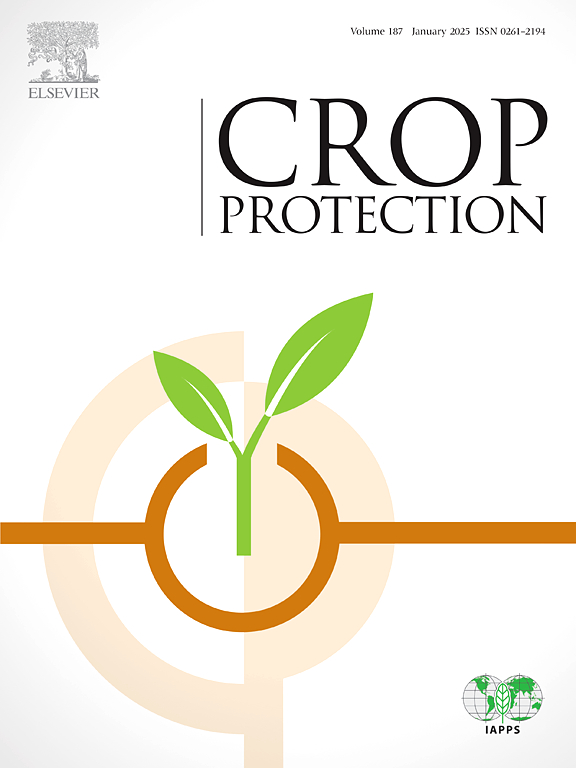Resistance of ten Indonesian cassava cultivars to the cassava lacebug, Vatiga illudens (Drake) (Hemiptera: Tingidae), a newly invasive exotic species in Asia
IF 2.5
2区 农林科学
Q1 AGRONOMY
引用次数: 0
Abstract
The cassava lacebug, Vatiga illudens (Drake) (Hemiptera: Tingidae), is a pest that feeds on cassava foliage, significantly reducing the yield of tuberous roots. Recently introduced to Asia, this invasive exotic pest has been reported only in Indonesia, where it poses a serious threat to cassava cultivation. This study aimed to determine the resistance levels of ten Indonesian cassava cultivars to V. illudens. The leaf nutritional profile (proximate content), as well as phenol and hydrogen cyanide (HCN) content, were analyzed as potential factors affecting the biological parameters of V. illudens. Results from the choice test revealed that V. illudens adults exhibited a clear preference for certain cultivars, with the highest numbers observed on Gajah (10.00 individuals), Adira 1 (5.60 individuals), and Mentega (5.20 individuals). In contrast, adult numbers on the remaining cultivars were lower, ranging from 2.40 to 3.60 individuals. In the no-choice antibiosis test, the nymphal developmental period (from first instar to adult) ranged from 11.70 to 20.40 days, while adult longevity varied from 9.05 to 16.30 days. Leaf HCN content was the only chemical property found to be associated with the degree of resistance in cassava cultivars, with low-HCN cultivars like Gajah (9.66 mg/g) and Mentega (11.26 mg/g) being more preferred by V. illudens. The insect also exhibited faster development and extended adult longevity on these cultivars, leading to increased population growth. These findings are expected to provide valuable information for the management of V. illudens.
印度尼西亚10个木薯品种对亚洲新入侵外来种木薯粉虱(半翅目:粉虱科)的抗性
木薯粉虱(半翅目:粉虱科)是一种以木薯叶为食的害虫,严重降低了木薯块根的产量。这种外来入侵害虫最近被引入亚洲,据报道仅在印度尼西亚发现,对木薯种植构成严重威胁。本研究旨在测定10个印尼木薯品种对紫病菌的抗性水平。分析了叶片营养成分(近似值)、酚和氰化氢(HCN)含量是影响紫花苜蓿生物学参数的潜在因素。选择试验结果表明,不同品种的成虫对不同品种有明显的偏好,其中以加加(10.00只)、阿迪拉1(5.60只)和门特加(5.20只)数量最多。其余品种的成虫数较低,在2.40 ~ 3.60个之间。在无选择抗生素试验中,若虫发育周期(从1龄到成虫)为11.70 ~ 20.40 d,成虫寿命为9.05 ~ 16.30 d。叶片HCN含量是发现的唯一与抗性程度相关的化学性质,低HCN的品种如Gajah (9.66 mg/g)和Mentega (11.26 mg/g)更受紫斑梭菌的青睐。昆虫在这些品种上也表现出更快的发育和更长的成虫寿命,导致种群增长。这些发现有望为紫斑菌的治疗提供有价值的信息。
本文章由计算机程序翻译,如有差异,请以英文原文为准。
求助全文
约1分钟内获得全文
求助全文
来源期刊

Crop Protection
农林科学-农艺学
CiteScore
6.10
自引率
3.60%
发文量
200
审稿时长
29 days
期刊介绍:
The Editors of Crop Protection especially welcome papers describing an interdisciplinary approach showing how different control strategies can be integrated into practical pest management programs, covering high and low input agricultural systems worldwide. Crop Protection particularly emphasizes the practical aspects of control in the field and for protected crops, and includes work which may lead in the near future to more effective control. The journal does not duplicate the many existing excellent biological science journals, which deal mainly with the more fundamental aspects of plant pathology, applied zoology and weed science. Crop Protection covers all practical aspects of pest, disease and weed control, including the following topics:
-Abiotic damage-
Agronomic control methods-
Assessment of pest and disease damage-
Molecular methods for the detection and assessment of pests and diseases-
Biological control-
Biorational pesticides-
Control of animal pests of world crops-
Control of diseases of crop plants caused by microorganisms-
Control of weeds and integrated management-
Economic considerations-
Effects of plant growth regulators-
Environmental benefits of reduced pesticide use-
Environmental effects of pesticides-
Epidemiology of pests and diseases in relation to control-
GM Crops, and genetic engineering applications-
Importance and control of postharvest crop losses-
Integrated control-
Interrelationships and compatibility among different control strategies-
Invasive species as they relate to implications for crop protection-
Pesticide application methods-
Pest management-
Phytobiomes for pest and disease control-
Resistance management-
Sampling and monitoring schemes for diseases, nematodes, pests and weeds.
 求助内容:
求助内容: 应助结果提醒方式:
应助结果提醒方式:


